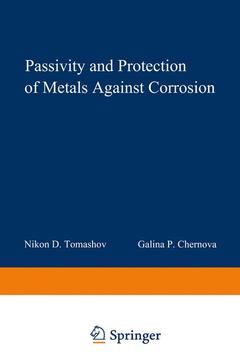Description
Passivity and Protection of Metals Against Corrosion, Softcover reprint of the original 1st ed. 1967
Author: Tomashov N. D.
Language: English
Keywords
Galvano; Ion; Potentiostat; Titan; Zirconium; chromium; corrosion; diffraction; iron; kinetics; mechanisms; metals; polarization; zinc
Approximative price 52.74 €
In Print (Delivery period: 15 days).
Add to cart
Publication date: 03-2012
208 p. · 15.2x22.9 cm · Paperback
208 p. · 15.2x22.9 cm · Paperback
Description
/li>Contents
/li>
Considerable progress has been made in the past 20 years toward understanding the basic mechanisms of corrosion, and the application of this knowledge to its control. From the very beginning, educational institutions and industrial research laboratories have contributed greatly toward determining and elucidating the fundamental principles of corrosion reactions. Some of the basic principles involved in cor rosion of metals can be credited to early investigators. Michael Faraday in 1830-1840 studied the relationship between the quantity of a metal dissolved and the electric current which was produced by this reaction. He also proposed that the passivation of iron was through the formation of a film and that the dissolution of a metal was electro chemical in nature. Sir Humphrey Davy in 1824 worked out the funda mentals of galvanic corrosion of ships' hulls and applied sacrificial zinc anodes to protect them from sea water corrosion. Richard Arlie in 1847 demonstrated that corrosion produced by oxygen at the surface of iron in a flowing stream generated a current. With the fundamental knowledge available to him from these early investigators, Willis Rodney Whitney developed and expressed, in its most useful form, one of the basic scientific principles which provides modern corrosion specialists with a fundamental basis of corrosion control. Dr. Whitney concluded that corrosion of iron is electrochemical, and that the rate is simply a function of the electromotive force and resistance of the circuit.
A Note on Soviet Alloy Designations.- I The Phenomenon of Passivity in Metals.- Definition of Passivity.- Mechanism and Theory of Passivity.- Electrochemical Methods for Investigating Passivity.- Anodic Potentiostatic Charge Curves.- Anodic Galvanostatic Charge Curves.- Cathodic Reduction Curves.- Study of Potential Drop Curves.- Measurement of the Double-Layer Capacity.- Study of the Kinetics of Electrode Processes Under the Action of Alternating Currents.- Investigation of the Nature and Structure of Passive Films..- Optical Method.- Electron Diffraction.- Microchemical Method for Determining Film Composition.- Kinetics of the Anodic Processes.- Anodic Processes on a Passive Electrode.- Method of Plotting Potentiostatic Curves.- II Passive Systems.- Active State.- Passive-Active State.- Spontaneously Stable Passive State.- Pitting Formation.- The Transpassive State and Secondary Passivity.- Construction of Corrosion Rate-Potential Curves.- III Basic Principles for Increasing the Corrosion Resistance of Alloys by Increasing Their Passivity.- Inhibiting the Anodic Process.- Mechanism of Increasing Passivity by Alloying.- Factors Determining Anodic Passivation of Alloys.- Effect of the Anodic Process on Passivity of Alloys.- Reduction of Corrosion in Passive Systems by Increasing the Effectiveness of the Cathodic Process.- Effect of the Cathodic Process on Passivity of Alloys.- Mechanism of the Effect of Cathodic Alloying Elements.- Significance of Anodic Passivation in Cathodic Alloying.- Increase in Corrosion Resistance of Stainless Steels, Titanium, Zirconium, and Chromium by Alloying with Cathodic Additives.- IV Anodic Protection.- Anodic Protection of Stainless Steels.- Effectiveness of Anodic Protection.- Effect of Various Factors on the Parameters of Anodic Protection.- Radius of Effective Anodic Protection.- Anodic Protection and Intergranular Corrosion.- Anodic Polarization and Corrosion Cracking.- Effect of Halide Ions on Anodic Protection.- Anodic Protection of Carbon Steels.- Anodic Protection of Titanium.- Anodic Protection of Titanium in Sulfuric Acid.- Anodic Protection of Titanium in Hydrochloric and Other Acids.- Practical Application of Anodic Protection.- Prospects for the Development of Anodic Protection.- V Passivation of Metals by Contact with Cathodes.- Use of Cathodic Protectors.- Protection with Metallic Cathodes.- Protection with Oxide Cathodes.- Protection Against Hydrogen Embrittlement and Corrosion Cracking.- Cathodic Coatings.- of Cations of Electropositive Metals into the Corrosive Medium.- VI Passivation of Metals by the Introduction of Oxidizers into the Corrosion Medium.- Mechanism of the Protective Effect of Oxidizing Inhibitors.- Inhibitors Which Retard the Anodic Process.- Oxidizers Which Increase the Effectiveness of the Cathodic Process.- Nature of the Oxidizing Inhibitor.- Effect of the Metal and Aggressiveness of the Medium.- References.
© 2024 LAVOISIER S.A.S.
These books may interest you

Atmospheric Corrosion 131.30 €



